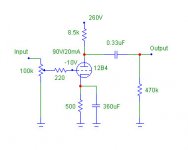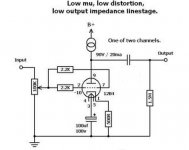Hi,
So? One could replace that valve with any voltage reference, it would still generate noise.
I've designed phono stages that use valved voltage references and they too are dead quiet.
These valves do have their advantages.
Cheers,
I enclose here a noise generator from Scroggie's book where an 85A1 is the noise source
So? One could replace that valve with any voltage reference, it would still generate noise.
Perhaps if this was a high gain circuit like a tape head or phono stage it would matter a lot. Not the case here.
I've designed phono stages that use valved voltage references and they too are dead quiet.
These valves do have their advantages.
Cheers,
Hi jcdrisc,
Anyway, back in time, engineers were forced to use gas regulators because that is all they had. Solid state zener diodes can drift more than a gas regulator tube. Hmmmm, maybe those regulator tubes aren't all that bad as a reference. Their use in a modern tube based component really is a good choice after all.
-Chris
I'm pretty sure that Frank and all the rest of us know this. Gas regulators have another trait. Some can settle at a different voltage every time it strikes. These are minor variances, but can throw some test instruments out of calibration.I make again the firm assertion that ALL gas tube regulators are noisy, fdegrove.
Anyway, back in time, engineers were forced to use gas regulators because that is all they had. Solid state zener diodes can drift more than a gas regulator tube. Hmmmm, maybe those regulator tubes aren't all that bad as a reference. Their use in a modern tube based component really is a good choice after all.
-Chris
can you show schematic of pre 12B4?At the urging of a couple of other DIY members that claimed the 12B4 would stomp the Rosenblit Grounded Grid I decided to persur building one.... <snip>
I suggest that you contact
BTB Elektronik Vertriebs GmbH
Kepler Str. 6, 90766 Fürth
Deutschland
Tel: +49 911 288585
Fax: +49 911 289191
Email: info@btb-elektronik.de
I have bought tubes from them several times. Nice prices, and quick shipment. They have a million tubes in stock.
BTB Elektronik Vertriebs GmbH
Kepler Str. 6, 90766 Fürth
Deutschland
Tel: +49 911 288585
Fax: +49 911 289191
Email: info@btb-elektronik.de
I have bought tubes from them several times. Nice prices, and quick shipment. They have a million tubes in stock.
Hi first of all thank you very much for this very nice thread.This is the basic 12B4 that I found. Hopefully I'm not stepping on anyones toes posting this here..... note that I used 220 UF for the cathode bypass caps. That is the only deviation from this drawing that I did.
Mark
At the cost to be banned i have to ask. I am attaching your schematic.
I understand that the plate load resistor (8.5k) should be not smaller than tube plate resistance (i.e. 1030 ohm from datasheet) ?
As i am looking for as low as possible Zout could be possible to decrease the 8.5k resistor and consequently the 260V supply ? should not this lower the Zout ?
like using a 2kohm vs. 8.5kohm resistor and 130V vs. 260V ?
Thanks a lot again
Attachments
Last edited:
....on Ebay you can find some offers from German sellers!
Cheers
Peter
Bought from German sellers. Danke schön!
@ginetto61
Good engineering practice makes the net load a triode works into at least 3X said triode's plate resistance (RP). Remember, the driven downstream load is in parallel with whatever device is between B+ and the tube's anode, insofar as AC is concerned.
I'm providing the signal schematic of the 12B4 line stage variant I'm associated with. A 130 VDC B+ rail should work. How high the quality of the CCS used depends on how difficult the downstream load is. If the downstream load is not especially awkward, a 10M45S integrated circuit is adequate.
Good engineering practice makes the net load a triode works into at least 3X said triode's plate resistance (RP). Remember, the driven downstream load is in parallel with whatever device is between B+ and the tube's anode, insofar as AC is concerned.
I'm providing the signal schematic of the 12B4 line stage variant I'm associated with. A 130 VDC B+ rail should work. How high the quality of the CCS used depends on how difficult the downstream load is. If the downstream load is not especially awkward, a 10M45S integrated circuit is adequate.
Attachments
@ginetto61
Good engineering practice makes the net load a triode works into at least 3X said triode's plate resistance (RP). Remember, the driven downstream load is in parallel with whatever device is between B+ and the tube's anode, insofar as AC is concerned.
I'm providing the signal schematic of the 12B4 line stage variant I'm associated with. A 130 VDC B+ rail should work. How high the quality of the CCS used depends on how difficult the downstream load is.
If the downstream load is not especially awkward, a 10M45S integrated circuit is adequate.
Hi ! thank you so much again. I have understood at least that the 12B4 is indeed a great candidate for line stage preamps. I have to study a lot more.
I end my ramblings with a question ... considering how difficult is to drive properly a solid state power amp with a tube ... is this really a sane decision ? i start to doubt it.
Nevertheless i know of some hybrid amps on the market that have praised for great sound. And many audiophiles indeed use tube line stages with solid state power amps.
Most of commercial line preamps adopt a cathode follower design to lower the Zout
maybe not the most elegant solution but it seems to work
A CF will simplify a lot the task for sure ... it looks like almost all medium mu tubes can work fine as GF ?
Like a 12bh7 CF ? or 6922 ... 6dj8 ... any tube around would be just fine
What is your take on CF ? i do not need any Vgain ... i have always too much gain But i appreciate what tubes provide to the sound.
It is more relaxed, ample ... i tend to forget the system and focus more on the music ... this is very very important for me.
Thanks a lot again
Have a nice day,
gino
Last edited:
Properly functioning tube HIFI circuits don't significantly distort. A correctly setup cathode follower is very linear and transparent.
The IHF "standard" load is 10 Kohms. Most common cathode triode voltage amplifiers can't handle that. The 12B4 can, as its RP is quite small at (sic) 1030 Ω.
What harmonic distortion linear triodes wired common cathode produce is primarily 2nd order and that's euphonic.
Use the common cathode 12B4 and "pad" the level control, if you get a "hair trigger" situation.
The IHF "standard" load is 10 Kohms. Most common cathode triode voltage amplifiers can't handle that. The 12B4 can, as its RP is quite small at (sic) 1030 Ω.
What harmonic distortion linear triodes wired common cathode produce is primarily 2nd order and that's euphonic.
Use the common cathode 12B4 and "pad" the level control, if you get a "hair trigger" situation.
Properly functioning tube HIFI circuits don't significantly distort. A correctly setup cathode follower is very linear and transparent. The IHF "standard" load is 10 Kohms. Most common cathode triode voltage amplifiers can't handle that.
this is a very fundamental point for me. To understand better ... a 12bh7 CF cannot drive a 10kohm power amp properly ? this really shocks me and changes my mind
then a power triode is the minimum required. I am very surprised. a 10kohm load is not uncommon among ss power amps.The 12B4 can, as its RP is quite small at (sic) 1030 Ω.
What harmonic distortion linear triodes wired common cathode produce is primarily 2nd order and that's euphonic.
Use the common cathode 12B4 and "pad" the level control, if you get a "hair trigger" situation
Now i understand why i perceive some weakness in the sound out from the cheap preamp i am using. With 6N3 tubes .... it has no chance to drive a low Zin power amp properly ?
Thanks a lot again.
Last edited:
Eli was saying that most common cathode triode voltage amplifiers (e.g. the topology shown in post #813) can't handle a 10k load, not that cathode followers can't handle a 10k load
By the way i see many SRPP designs ... but they are more complex
Last edited:
Eli was saying that most common cathode triode voltage amplifiers (e.g. the topology shown in post #813) can't handle a 10k load, not that cathode followers can't handle a 10k load.
Correct! The O/P impedance of a cathode follower is approx. = 1/gm.
Adhering to the textbook 1:10 rule for a triode cathode follower is easy enough, when working into that 10 Kohm IHF number. A cathode follower O/P impedance <= 1000 Ω does the trick. For instance, take the triode found in 6SN7s, whose gm is roughly 2.7 mA./V. Wired as a cathode follower, the 6SN7 triode's O/P impedance is approx. 370 Ω. Whether or not such a cathode follower can charge and discharge the net capacitance of the downstream load is another matter.
.001 uF total capacitance, is quite large for a 3 foot RCA to RCA cable, plus a power amp input capacitance.
(a total of 1000pF)
0.001 uF is 7,957 Ohms at 20kHz.
i would think that a 6SN7 cathode follower with an impedance of 370 Ohms should be able to drive 0.001 uF.
The capacitive reactance of 0.001 uF at 20kHz to driving impedance ratio is 21.5 to one.
The impedance is not the issue.
But the bias voltage on the cathode may determine the limit of the maximum voltage swing into the load.
(a total of 1000pF)
0.001 uF is 7,957 Ohms at 20kHz.
i would think that a 6SN7 cathode follower with an impedance of 370 Ohms should be able to drive 0.001 uF.
The capacitive reactance of 0.001 uF at 20kHz to driving impedance ratio is 21.5 to one.
The impedance is not the issue.
But the bias voltage on the cathode may determine the limit of the maximum voltage swing into the load.
- Status
- This old topic is closed. If you want to reopen this topic, contact a moderator using the "Report Post" button.
- Home
- Amplifiers
- Tubes / Valves
- Yet another 12B4 line stage, or is the 12B4 better than the Grounded Grid.....

